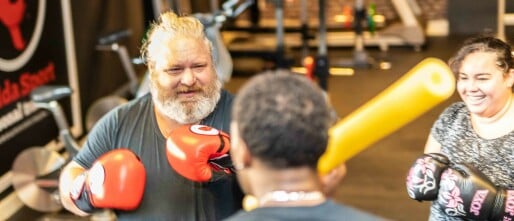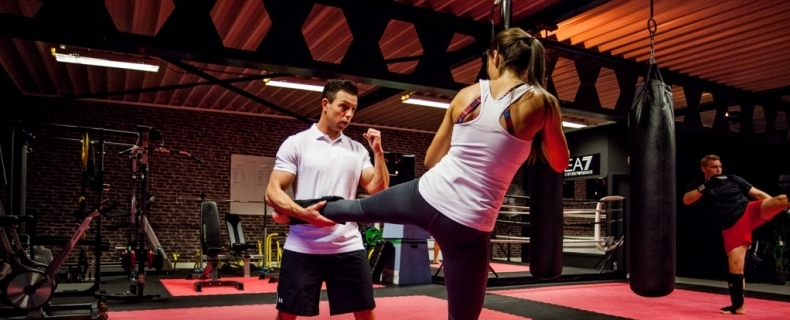Have you ever thrown kicks and punches at someone that sent him sprawling on the ground and made you feel you qualify to be a kickboxer? While kickboxing is a term used to describe any activity that entails throwing kicks and punches either in open space, at a heavy bag or another person, there are unique and different techniques employed which are learned through vigorous and regular training.
Kickboxing and Its Benefits
Kickboxing is a combination of different sports such as American boxing, Tae Kwon Do, Karate and Muay Thai. Each of these sports has different values, techniques, and beliefs depending on its origin. Due to the immense benefits such as total-body exercise, improving the health of the body, mind, and heart, weight loss and relieving stress, kickboxing has rapidly grown in popularity.
While you can train at home alone by following tutorials or watching a DVD, kickboxing class for beginners is very important. Apart from having an instructor who teaches and observes your progress, the course also gives one the opportunity to work out with a group. In the class, a beginner kickboxer learns how to kickbox, work hard, burn calories as well as some kickboxing tips. You also learn the basic kickboxing techniques for beginner such as how to generate power and have effective moves by using effective punches and kicks resulting in better coordination, agility, balance, and strength.

Basic Kickboxing Techniques
Before enrolling for the kickboxer beginner class, there are several tips that you should be aware of because they will come in handy in training. The following are some of the basic kickboxing techniques to have in mind before beginning kickboxing classes.
- Ensure to always warm up before doing any workout to alert and prepare the body for the work. Warming up helps to loosen the body muscles, tendons and ligaments as well as increase blood circulation in the body.
- You should aim to perfect your form before training on speed and power to ensure that your kicks are not useless due to poor execution. Starting slowly as you learn to avoid injury to yourself and others is one of the best ways to attain form perfection.
- Ensure you stay hydrated by taking lots of water before, during and after a workout. The vigorous movements and exertions results to a lot of sweating.
- Ensure always to stay focused and concentrate on yourself. Avoid getting carried away by the fantastic kicks and punches you see your neighbor doing because he has probably trained longer than you.
- During and after a workout, stretch yourself for flexibility and ensure a quicker recovery.
- Wearing protective gear during workout protects one from injury. Ankle supports to bolster the ankles and protect the top of the foot may be necessary for those who prefer to exercise barefoot.
 Having a pair of gloves ensures that the hands and wrists are well protected. Wraps may be worn underneath the gloves.
Having a pair of gloves ensures that the hands and wrists are well protected. Wraps may be worn underneath the gloves.
Wearing shorts and vests also improves comfortability and flexibility and ensures the legs and arms are not restrained but can move and turn all round easily.
- Ensure you keep yourself in a good balanced and comfortable position before, during and after attacking.
- Raise your arms up and keep them relaxed while protecting yourself from punches. Ensure to keep your chin down at all times.
- Beginners should have some basic tips on how to handle an injury such as using ice, wrapping to reduce swelling and elevating the injured part above the heart to reduce blood flow. Kickboxing beginners should have some basic First Aid knowledge.
- Safety starts with you. Protecting yourself from injury should be a top priority hence a beginner should learn the basic kickboxing protection tips.
Tactical Techniques
To become a good and effective kickboxer, beginners should understand the basic principles and tactical techniques of the sport. The following are some of the tactics.
Distance
A fighter should be able to accurately judge the distance between him and the opponent before throwing a kick or a punch. A kick thrown far from the opponent doesn’t generate any power while one thrown too close could result to the leg jamming.
Defense
Having excellent and efficient defensive skills makes it difficult for the opponent to find a target. Some techniques for effective defense include parrying, blocking, dodging, rolling with the punch and sidestepping.
Feinting
Feinting involves deception and giving false anticipation to keep the opponent guessing. It disables the opponent psychologically hence getting easy punches and scores.
Timing
Timing is the most critical aspect of a kickboxer and ensures that you throw punches and kicks at the target without missing.
Other useful techniques a beginner should have include power, endurance, and sparring.
- Having a partner to train with regularly is an essential technique that a beginner can employ. The partner should be at the same level as you to ensure that you grow together. Always discuss with your partner on the parameters to follow before starting training. Some of those agreements may include the length of each training round, where and where not to hit, and the satisfactory force of impact to engage.
Conclusion
Embracing and practicing these basic kickboxing techniques for beginner ensures that a kickboxer learns all the tricks and eventually becomes a great and effective fighter. Fighters who pick bad habits and practices as they train usually are unable to get rid of them even as they advance in the career.






